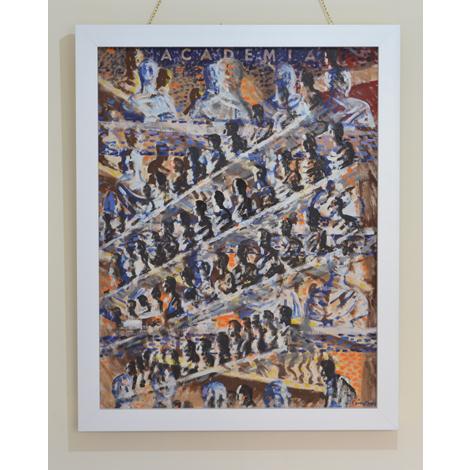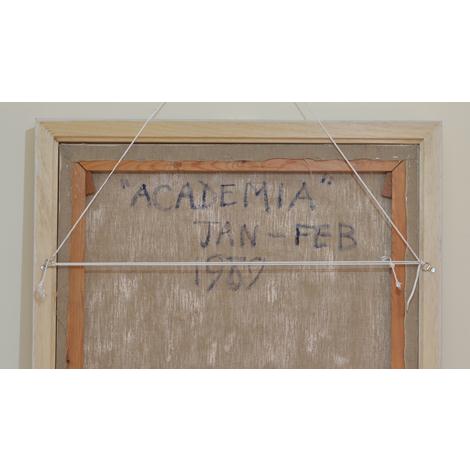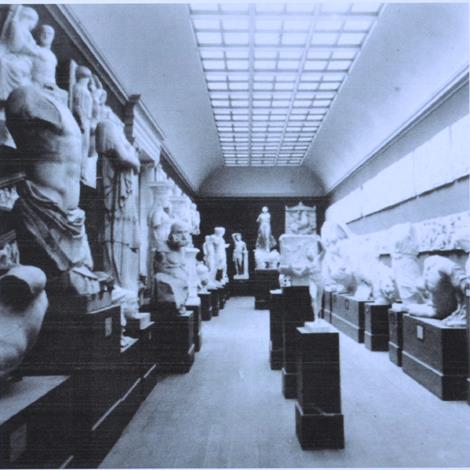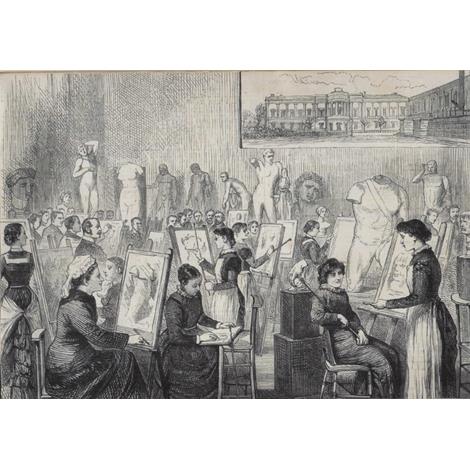Academia Derek Carruthers
This intriguing picture was painted at a time when Carruthers had long been questioning the burden of received culture. What are the processes of passing expectations down through the generations? How do the mechanics of change operate in time and place?
Thus, at first encounter, this vision of an endless series of Classical heads draws us back into the 19th century, when an Italian, Domenico Brucciana (d.1880), arrived from Lucca with a clever business plan. He set up shop in Covent Garden and sold thousands of casts to the Government Schools of Design, the British Museum and the V&A.; this did, after all, save the British from having to go on the Grand Tour. Students of art and design thus embarked on their rigorous training by drawing from the casts (see image attached, for reference), before they aspired to draw from the live model.
Today, the majority of these casts have been discarded - but there is, now, a re-awakening of interest in them, both for their accurate representation of Greek, Roman and Renaissance sculptures and reliefs which are now inaccessible or lost, and because they are, in themselves, a sign of a particular vision of what the practice of art might be: a place where Classical scholarship, archaeology, Western cultural norms, artist, patron and curator might meet in happy communion. The V&A has one of the best collections of casts - the Museum's Cast Courts were opened in 1873 and remain, 'among the most popular galleries in the V&A' - indeed, the refurbishment of the Courts is currently in hand. Amongst other reasons why collections of these casts still pull at the heart-strings must be because there is a degree of pathos attached to shelves of white heads and bodies, perhaps gathering dust; more, there is something distinctly disturbing about them. There is also - in these days of assertive individuality - a strange fascination for a time when the notion of what art - or, at least, a proper art education - was, seems to have been shared by so many. There must, after all, have been a degree of comfort in believing that, when you knew what you liked ... everyone else, of taste, probably liked the same.
If the nature of received culture must be questioned, what about the Modernist quandary of how space, perspective, movement and weight makes itself felt in two- as well as three-dimensional works of art? What are the physiological, psychological, mathematical, historical and cultural channels which convey an idea or an image between one person and another? On a simple level, the painting can be compared to one of M.C. Escher's graphic puzzles - playing with architecture, imagery, pespective. Certainly, Carruthers' Academia can challenge our understanding of space and time in a similar way.
If we really want to think about this, however, we need to ponder a little on the debates which, in the 1980s, filled universities and colleges (perhaps, especially Art Colleges, where Conceptualism had been profoundly influential in the 1970s). The philosophical questions raised by semiotics and linguistics must be examined: how is a maker of a 'sign' (a sentence, a picture, a poem) to know that the concept he has represented can be communicated to any recipient, who may have a hinterland of personal, cultural, political and even religious expectations, which lead him to expect something quite other? Metaphor, symbol, sign and communication - this is not an inevitable sequence.
This is a painting which keeps asking these questions. But it does more than simply make you work.
Academia is visually entertaining in its play with space. It is very striking, with its simple scheme of black and white, blue and orange; engaging in its array of dots and dashes, serpentine squiggles and architectonic angles. Live with this picture - it will keep drawing you back.
89.5cms x 69cms
100cms x 80cms




